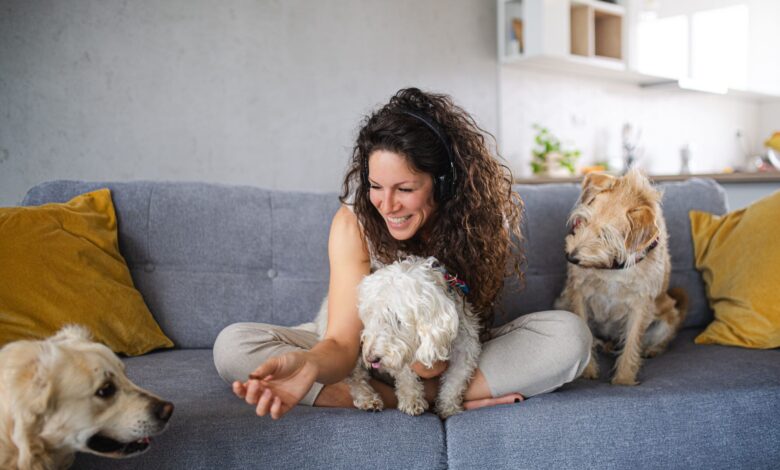How to Become a Pet Sitter – Dogster

[ad_1]
How do you become a pet sitter? What if you have no experience? We’ve got answers from some of the nation’s top experts.
“You should take an inventory of your pet-care experience and knowledge,” says Beth Stultz-Hairston, president of Pet Sitters International (PSI), (an educational organization for professional pet sitters. “Consider questions such as your length of experience caring for your pets or pets of friends and family. What types of pets you have experience with? What type of relevant training you’ve had?”
If you need experience or want to ensure pet-sitting is in your wheelhouse, spend more time with animals.
“I highly suggest you volunteer at rescues or animal shelters,” says Amy Sparrow, president of the National Association of Professional Pet Sitters (NAPPS), the national nonprofit organization for professional pet-sitters. “Work at vets’ offices, kennels and doggy daycares.”
Pet sitters often transition to animal care from other industries. Suzanne Thomsen worked in corporate America and then as a teacher. She wondered if pet-sitting might be preferable to the boardroom and classroom.
The North Carolina mom had caregiving experience raising her children and dogs. Four years ago, she got her first pet sitting job and now has a new “leash” on a fulfilling career.
“I have my own hours, no constant requests and deadlines, no political environments, no demanding superiors, no talking-back students,” Suzanne says. “Pet-sitting is a relaxed environment with loving pets that only want your love.”
But before you quit your day job make sure you’re OK not working 9 to 5. Pet sitters work rain or shine, nights, weekends and holidays — popular times people go away.
Get certified as a pet sitter and join pet-sitting organizations
Though no federal regulations require pet sitters to have specific training, dig into certifications that prove you’re responsible and ready for emergencies.
Formal training in pet CPR and first aid is critical. PSI and NAPPS offer pet-sitter education and certifications that make you stand out from the pack.
“The pet-owning public needs an easily identifiable way to determine the most qualified, knowledgeable, professional pet-sitting options,” Beth says.
Join professional organizations to network and share information. Amy runs her own pet sitting company, but she learned from others in the biz as a newbie. “The smartest thing I did was join an association. I asked established members what they wish they would have done so I wouldn’t make the same mistakes,” Amy says.
How to start a pet-sitting business
First, decide how to run your pet business or service. Do you want to work for a company, start your own or work for yourself?
According to a PSI survey of its members, 99% of pet-sitting businesses are independently owned, and more than half are sole proprietors with no employees.
Even if you’re a one-person operation or work as an independent contractor through a pet care app like Rover or Wag!, create a plan for your accounting, tax and legal issues.
“One of the biggest downfalls of aspiring pet sitters is lack of business knowledge,” Beth says. “It’s important to seek out the tools and resources you’ll need to run a business efficiently and effectively.”
Hire an accountant and attorney or consult pet-sitting associations or the U.S. Small Business Administration for resources.
If you add employees, follow all the local, state and federal rules so you don’t end up in the doghouse. You may need to file a “doing business as” registration with your city or incorporate as a business with your state.
Pet sitter insurance

Be sure to get insurance. Even if you pet sit a few hours a month, you’re offering a service and could be liable if something goes wrong.
“General liability insurance is a must-have for all businesses,” says Janet Ruiz with the Insurance Information Institute. “It protects you and your company from common lawsuits arising from everyday business activities. It will cover you if the dog you were walking bit someone.”
If you drive pets in your car or bring them to your home, your auto or homeowners’ insurance may not pay if something happens while you’re on the job. Talk to an insurance agent about coverage. If you’re certified, you may get a discount.
“We often see businesses fail when they don’t have insurance and suffer losses,” Janet says. “Businesses with insurance are more likely to recover from losses.”
Amy has customized coverage for her clients’ pets and property.
“I have clients in multimillion-dollar homes,” she says. “I worry about a dog knocking a vase over or a dog who starts limping. The insurance covers that.”
How to find pet-sitting jobs
Demand for pet sitters is at an all-time high. Many pet care businesses are racing to hire more employees. Find a local pet-sitting business with openings or work through websites and apps that connect sitters with pet parents. Note that some companies take a cut of what you make. If you want to create your own company, paw through the following items before you get started as a pet sitter.
- Decide on a memorable name for your pet-sitting service
- Create a logo
- Set up a website
- Order business cards
- Start advertising: Post flyers at dog parks, on social media and ask people to spread the word.
Ask for reviews after each successful pet-sitting job. “Your reputation is your most important thing,” Amy says.
Suzanne started by creating a profile on Rover. “You set your parameters: the number of pets, size of pets and distance you will travel. You set your fees,” Suzanne says.
Before a pet sitter can post a profile on Rover, she must pass a criminal background check, pass a safety quiz on pet body language and be approved by the company.
“Rover empowers our community of pet sitters and dog walkers to grow their businesses through our platform,” says Kate Jaffe, trends expert at Rover. “With the tools and resources we provide, sitters have the flexibility to set their own rates, schedules, services and choose which bookings they accept, so they can create a pet-care business that matches their unique needs.”
Wag! also requires caregivers to submit a profile, pass a pet-safety quiz, a background check and have business insurance. Once your profile is approved, you can start working that day.
“It could take months or years for a caregiver starting out on their own to find enough business to make their business a reality,” says Keith Mosley with Wag!. “But pet parents are submitting requests for both on-demand services and scheduled requests on the Wag! app.”
Going rate for pet sitters
“What should I charge?” is one of the most popular questions PSI receives from pet sitters.
The organization’s most recent survey found the average fee for a 30-minute pet-sitting visit was $24.18. An overnight visit averaged about $90.82. Pet-sitting rates vary depending on where you live.
“It’s important to research the going rate in your service area,” Beth says. “It’s also important to calculate your overhead business costs when determining your rates to ensure you can make a profit.”
Ask your clients to sign a contract specifying your role, rate and payment. “That’s just a smart business practice,” Amy says.
Words of advice for pet sitters
Network with other pet sitters to have backup caregivers in case you have to cancel.
Ask potential clients to fill out a questionnaire about their pets. Be honest if you don’t feel you can handle their animals’ care.
Suzanne insists on meeting pets before accepting a job. She ensures she’s a good match, so everyone is safe rather than sorry.
“Having raised two children and taught hundreds of students, I know how important their safety and comfort are,” Suzanne says. “It’s no different when nurturing a pet.”
Questions to ask before becoming a pet sitter
Are you up for working weekends, nights and holidays?
Are you OK giving pets medication? Cleaning up if they get sick?
Are you calm in emergencies? With animals, there’s rarely a dull moment.
Do you have a plan for your health and business insurance and income taxes?
[ad_2]
Source link






